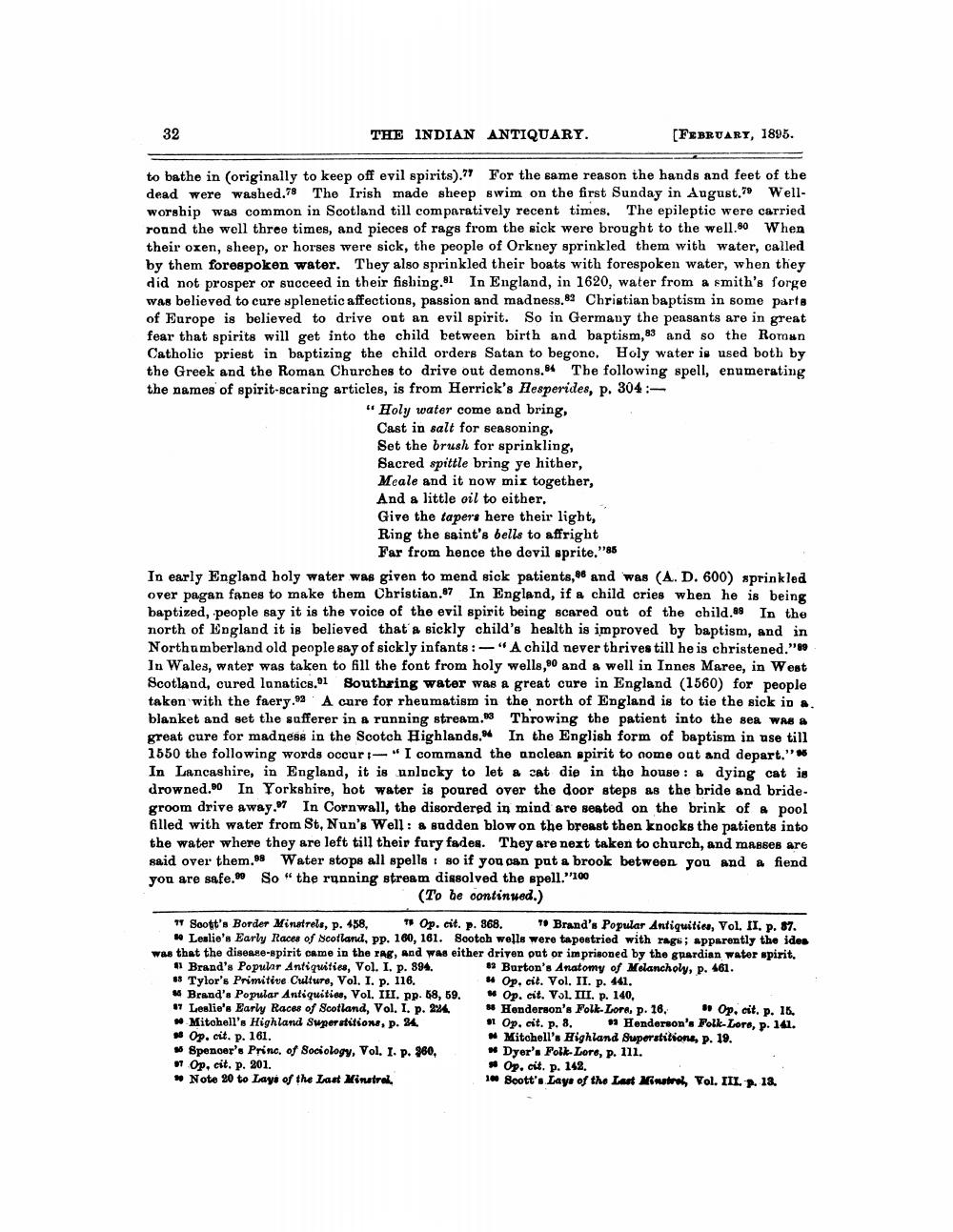________________
32
THE INDIAN ANTIQUARY.
[FEBRUARY, 1895.
to bathe in (originally to keep off evil spirits).7For the same reason the hands and feet of the dead were washed.78 The Irish made sheep swim on the first Sunday in August.79 Wellworship was common in Scotland till comparatively recent times. The epileptic were carried round the well three times, and pieces of rags from the sick were brought to the well.80 When their oxen, sheep, or horses were sick, the people of Orkney sprinkled them with water, called by them forespoken water. They also sprinkled their boats with forespoken water, when they did not prosper or succeed in their fishing.81 In England, in 1620, water from a smith's forge was believed to cure splenetic affections, passion and madness.83 Christian baptism in some parts of Europe is believed to drive out an evil spirit. So in Germany the peasants are in great fear that spirits will get into the child between birth and baptism,83 and so the Roman Catholic priest in baptizing the child orders Satan to begone, Holy water is used both by the Greek and the Roman Churches to drive out demons. The following spell, enumerating the names of spirit-scaring articles, is from Herrick's Hesperides, p. 304:
"Holy water come and bring,
Cast in salt for seasoning, Set the brush for sprinkling, Sacred spittle bring ye hither, Meale and it now mir together, And a little oil to either. Give the tapers here their light, Ring the saint's bells to affright
Far from hence the devil sprite."85 In early England holy water was given to mend sick patients, and was (A. D. 600) sprinkled over pagan fanes to make them Christian.97 In England, if a child cries when he is being baptized, people say it is the voice of the evil spirit being scared out of the child. In the north of England it is believed that a sickly child's health is improved by baptism, and in Northumberland old people say of sickly infants :-"A child never thrives till he is christened."99 In Wales, water was taken to fill the font from holy wells, and a well in Innes Maree, in West Scotland, cured lanatics.91 Southring water was a great cure in England (1560) for people taken with the faery.92 A care for rheumatism in the north of England is to tie the sick iD a. blanket and set the sufferer in a running stream. Throwing the patient into the sea was a great cure for madness in the Scotch Highlands. In the English form of baptism in use till 1550 the following words occur-"I command the anclean spirit to come out and depart." In Lancashire, in England, it is unlocky to let a cat die in the house : a dying cat is drowned.90 In Yorkshire, hot water is poured over the door steps as the bride and bridegroom drive away. In Cornwall, the disordered in mind are sented on the brink of & pool filled with water from St. Nun's Well: sudden blow on the breast then knocks the patients into the water where they are left till their fury fades. They are next taken to church, and masses are said over them.98 Water stops all spells i so if you can put a brook between you and a fiend you are safe.so So "the running stream dissolved the spell."100
(To be continued.)
1 Soott's Border Minutele, p. 458, Op. cit. p. 368. Brand's Popular Antiquities, Vol. II. p. 87.
9 Leslie's Early Races of Scotlanul, pp. 160, 161. Sootoh wells were tapestried with rags; apparently the ides was that the disease-spirit came in the TAR, and was either driven put or imprisoned by the guardian water spirit.
# Brand's Popular Antiquities, Vol. I, p. 894. #2 Burton's Anatomy of Melancholy, p. 461. 18 Tylor's Primitive Culture, Vol. I. p. 116.
Op. cit. Vol. II. p. 441. * Brand's Popular Antiquities, Vol. III. pp. 58, 59. * Op. cit. Vol. III. p. 140, 17 Leslie's Early Races of Scotland, Vol. I. p. 224 # Henderson's Folk-Lora, p. 16, Op. oit. p. 16 # Mitohell's Highland Superstitions, p. 24.
* Op. cit. p. 8. Henderson's Folk-Lors, p. 141. * Op. cit. p. 161.
* Mitohell's Highland Superstitions, p. 19. * Spencer's Princ. of Sociology, Vol. I. p. 360. * Dyer'. Folk-Lore, p. 111. Op. cit. p. 201.
Op. cit. p. 142. * Note 20 to Layi of the Last Minutral.
1Soott's Lays of the Last Minuts, Vol. IIL. P. 18.




